Tag: Kenneth Rowntree
Born in Scarborough, Kenneth Rowntree’s father was the manager of the local department store who displayed his work in the shop, this may have been why Rowntree changed from training to be a cellist to becoming an artist. He studied at the Ruskin Drawing School, Oxford and went to the Slade School in London.
In 1941, Rowntree had moved to Great Bardfield, settling with his wife Diana (née Buckley) into the “a handsome draughty house” Town House. There they would be neighbours to Edward Bawden and Eric Ravilious lived in Castle Hedingham a few miles away.
The paintings Kenneth Rowntree made during war time are rather curious because they are not on the front line. Unlike many of the other official war artists, Rowntree was a Conscientious Objector. He did paint the domestic scenes of life during wartime, but not pictures of the war maneuvers.
The picture below is of a Polo Ground is a good example of his work. The pitch as been converted into growing produce and the people working for the war effort but making food.
The figure of the man signifying the every man worker to me says ‘we are all in this together’. Below are five of his paintings for the War Artist Scheme.

Kenneth Rowntree – A Polo Ground in War-time, 1940
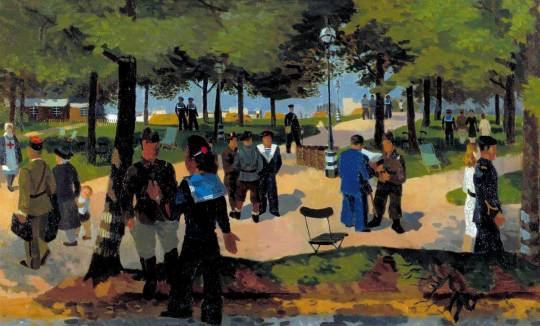
Kenneth Rowntree – Foreign Servicemen in Hyde Park: Early Summer, 1940
In the picture above, the mixture of uniforms is a good indication of how many parties are mixed up in the conflict. A subtle communication.
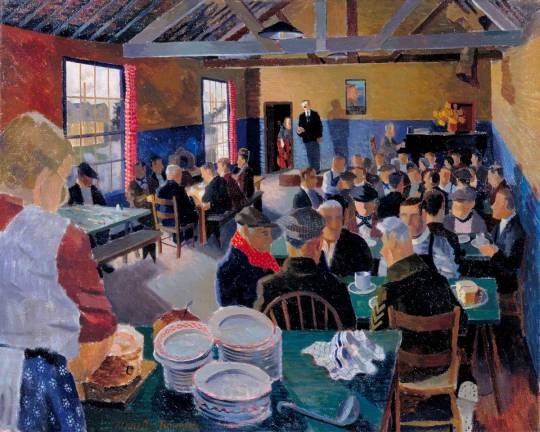
Kenneth Rowntree – The Council for the Encouragement of Music and the Arts Canteen Concert, Isle of Dogs, London, E14, 1940
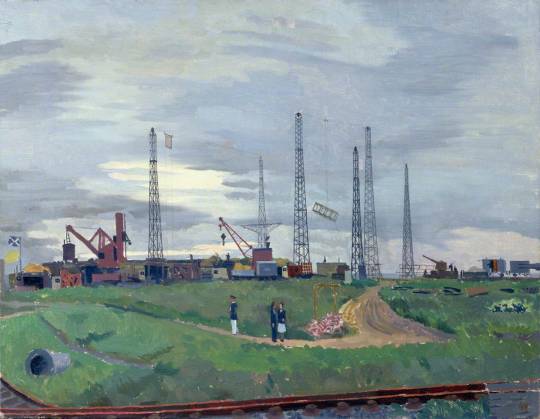
Kenneth Rowntree – The Experimental Establishment, Shoeburyness: Firing through Screens, 1945
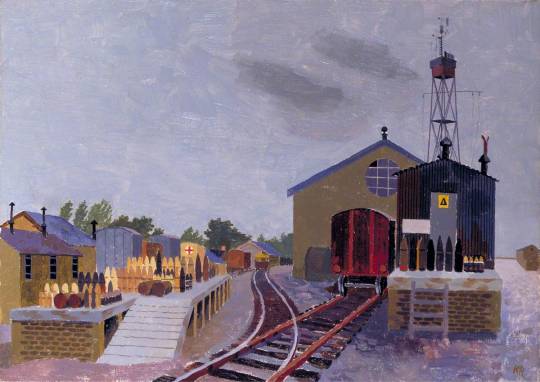
Kenneth Rowntree – Experimental Establishment, Shoeburyness, 1945
All the paintings below are part of the Recording Britain series.
In 1940, when the British landscape was under attack from the threat of German bombers, the Ministry of Labour, in association with the Pilgrim Trust commissioned many of Britain’s artists to go out and paint a record of the changing face of the country before it was too late. †
I think part of the romance of the pictures below is the lack of cars in pictures. No High Street in Britain will ever look beautiful again until cars are stored back in their garages and not parked on the street. Other than the Old Toll Bar House all the places are without figures, an empty world of architectural curiosity. I also feel that there is something beautiful about those multi-layered telegraph poles and wires in the same picture.

Kenneth Rowntree – Old Toll Bar House, Ashopton, 1940
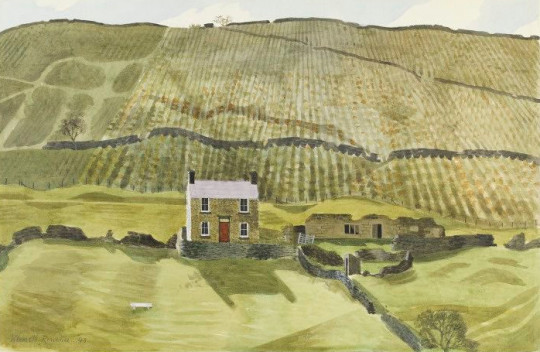
Kenneth Rowntree – Underbank Farm, Woodlands, Ashdale, Derbyshire, 1940
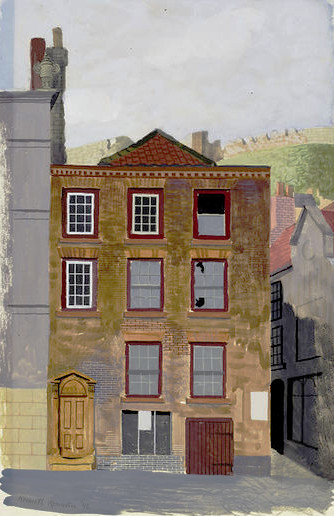
Kenneth Rowntree – Scarborough, 1940
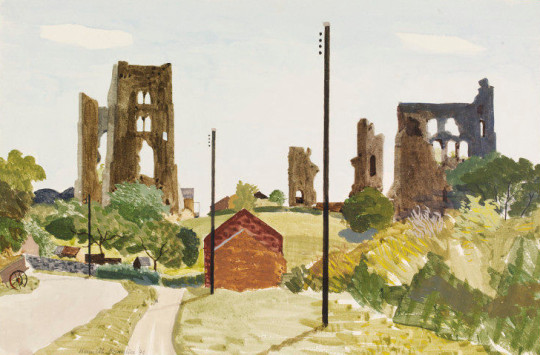
Kenneth Rowntree – The Castle, Sheriff Hutton, 1940
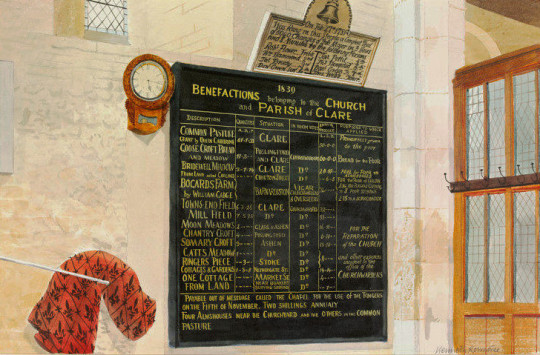
Kenneth Rowntree – The Bellringer’s Chamber, SS. Peter and Paul Church, Clare, 1940
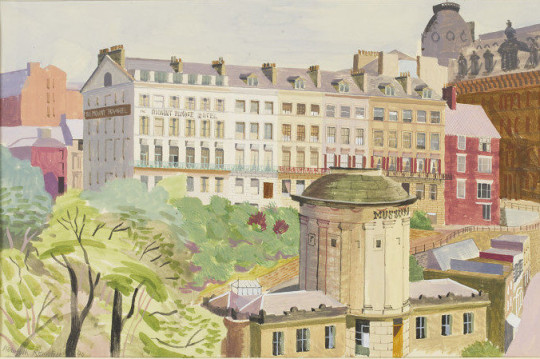
Kenneth Rowntree – Cliff Bridge Terrace and Museum, Scarborough, 1940
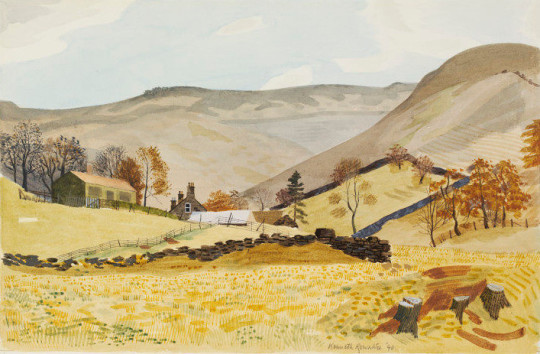
Kenneth Rowntree – Grainfoot Farm, Derwentdale, 1940
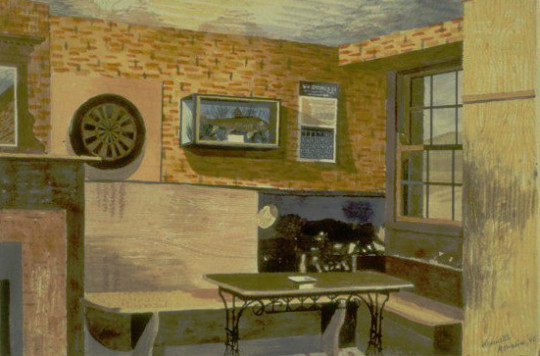
Kenneth Rowntree – The Smoke Room, Ashopton Inn, 1940
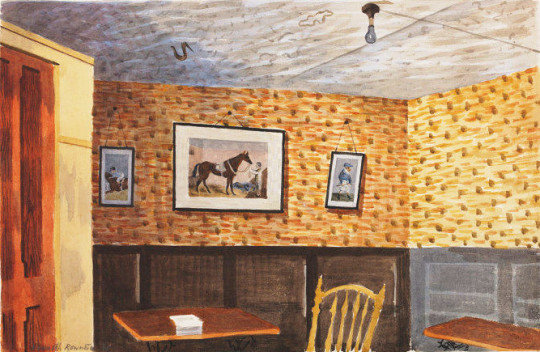
Kenneth Rowntree – The Smoke Room, Ashopton Inn, 1940
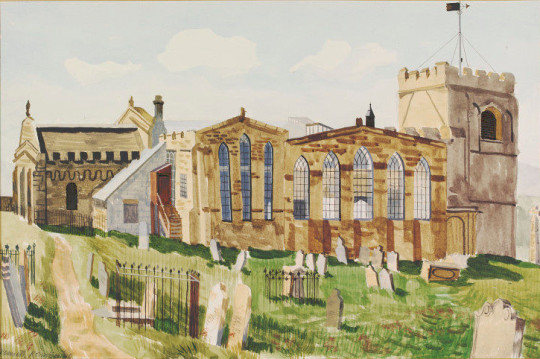
Kenneth Rowntree – St. Mary’s, Whitby – Exterior, 1940
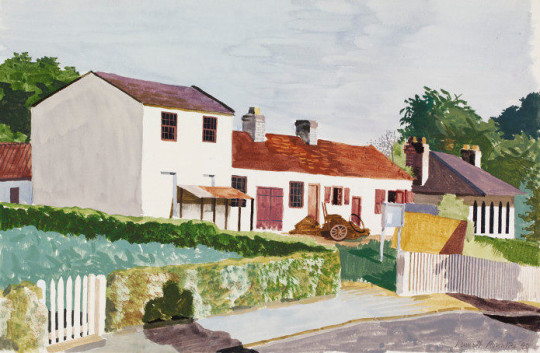
Kenneth Rowntree – The Smithy, Crathorne, 1940
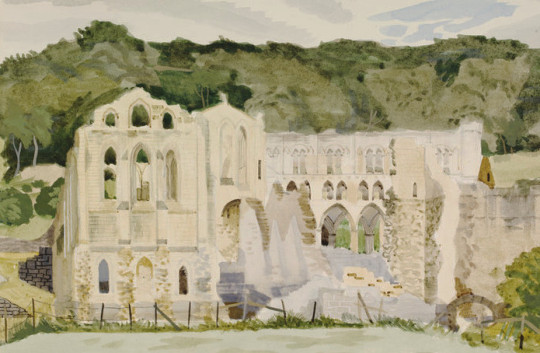
Kenneth Rowntree – Rievaulx Abbey, 1940

Kenneth Rowntree – West Front of the Priory Church, Dunstable, Bedfordshire, 1941
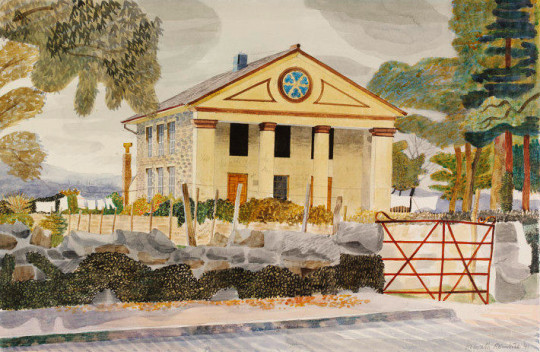
Kenneth Rowntree – Chapel Tremadoc, Caernarvonshire, 1941
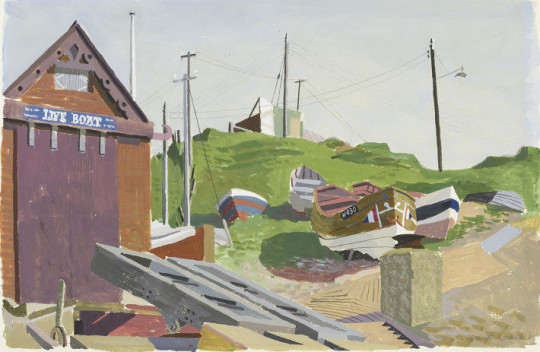
Kenneth Rowntree – North Landing, Flamborough, 1940
† David Mellor, Gill Saunders, Patrick Wright – Recording Britain , 1990
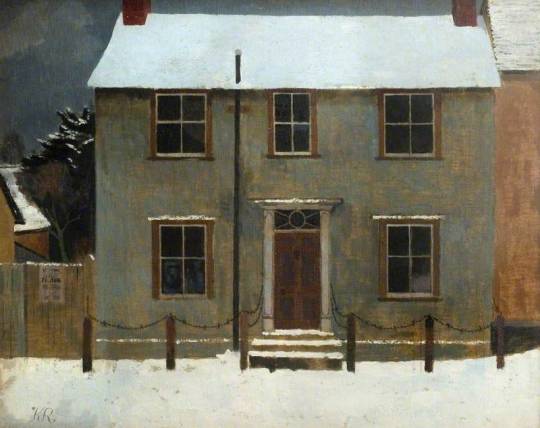
Kenneth Rowntree – Ethel House, Great Bardfield, 1942
In a previous post I featured the work of Walter Hoyle and his drawing of Little Saling Church in Bardfield Saling. In researching that I found the lovely paintings by Kenneth Rowntree below. The image above is Ethel House, Great Bardfield, where his friend Michael Rothenstein lived.
Rowntree trained at the Ruskin School of Drawing in Oxford, and then at the Slade in London. In 1939 he married the architect Diana Buckley. They associated with many of the modernist emigr architects in London at that time, and a strong architectural sense can often be felt in Rowntree’s work. He was a Quaker, and during the war became part of the ‘Recording Britain’ project, in which everyday life in wartime Britain was captured by a range of artists. When Diana became pregnant in 1941 they wished to move out of London, and Eric and Tirzah Ravilious found them a suitable house in Great Bardfield, close to the Bawdens’ home. Local churches provided a strong inspiration for much of his work here, but he also worked in London, Kent and Wales.
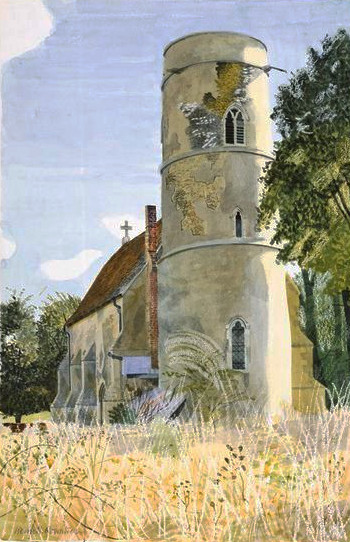
Kenneth Rowntree – SS Peter and Paul, Little Saling, Essex, 1942
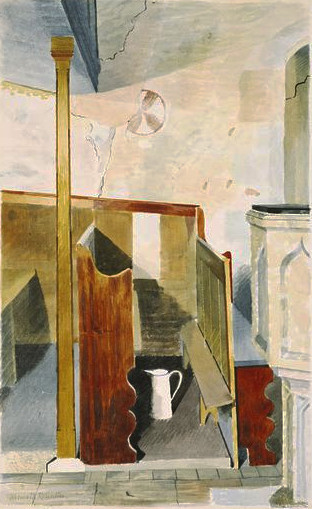
Kenneth Rowntree – Interior of SS Peter and Paul, Little Saling, Essex, 1942

Kenneth Rowntree – The Organ Loft, SS Peter and Paul, Little Saling, 1942
And here are two bonus pictures of nearby church in North End, again, inside and out.

Kenneth Rowntree – Exterior, Black Chapel North End, Nr. Dunmow, 1942
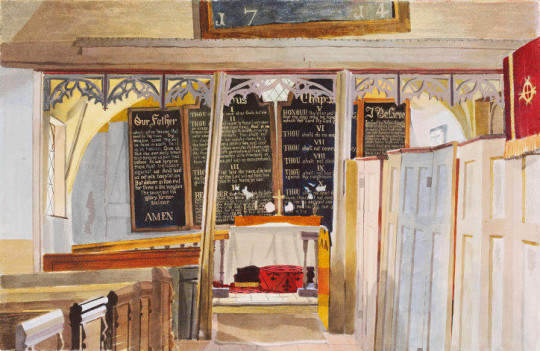
Kenneth Rowntree – Interior, Black Chapel, North End, near Dunmow, Essex, 1942
Here are some of the Christmas cards from various Great Bardfield artists. I have always thought it important to send out something decorative and interesting at Christmas and the Bardfield artists were the same.
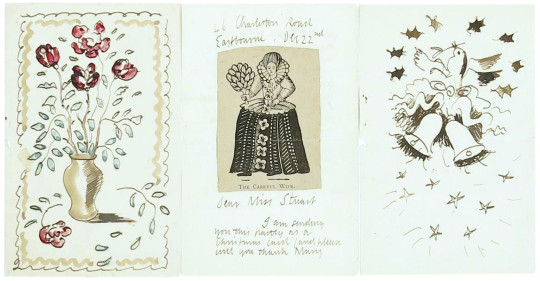
Eric Ravilious – Christmas Card
With some of the artists like Walter Hoyle the envelopes were just as important as the cards for decoration. Many of them were numbered as editioned prints. Signed from Walter and his wife Denise.

Walter Hoyle – Christmas Card Envelope, 1986
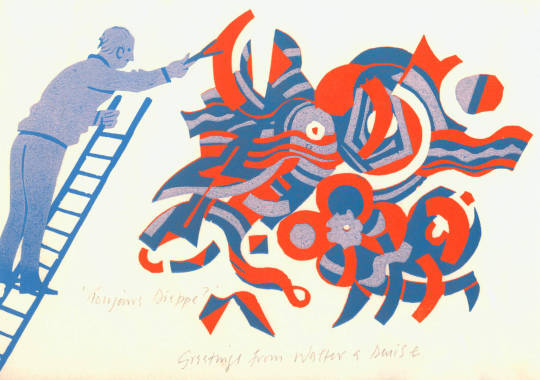
Walter Hoyle – Christmas Card, 1986
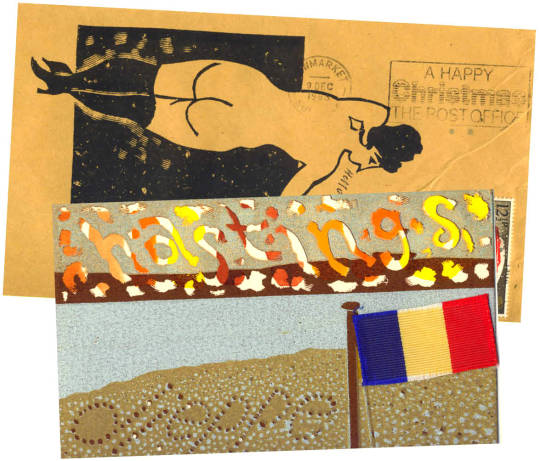
Walter Hoyle – Christmas Card and Envelope, 1983
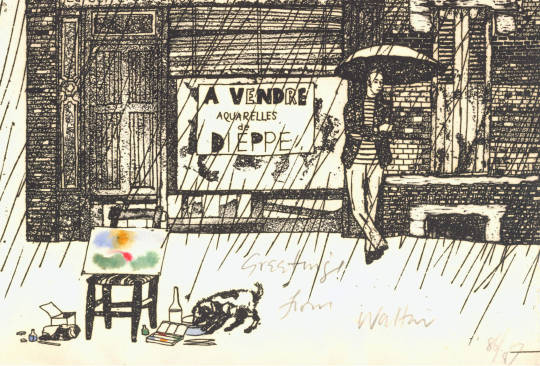
Walter Hoyle – Christmas Card
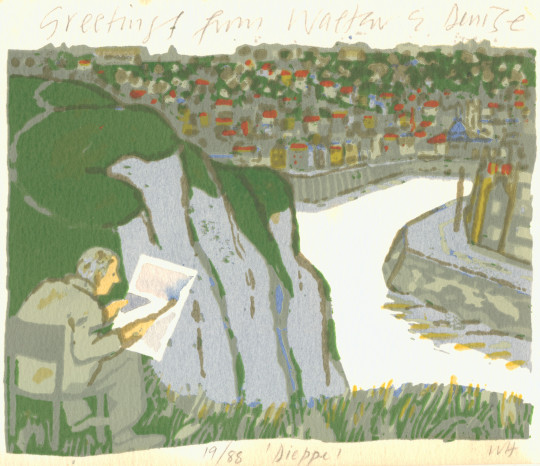
Walter Hoyle – Christmas Card
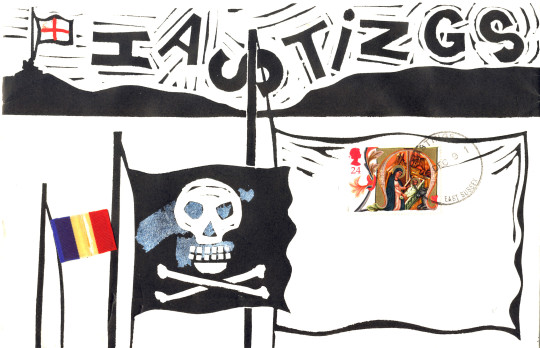
Walter Hoyle – Christmas Envelope
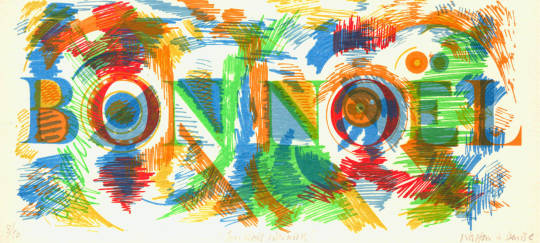
Walter Hoyle – Christmas Card

Michael Rothenstein – Christmas Card & Design for Faber and Faber, 1962
The note below is from Michael Rothenstein to David Bland of Faber and Faber. Faber were planning the Christmas card in June as the letter is dated 28th of that month. The picture above shows the finished design to the left and the prototype to the right.
Here is a further rough of the Christmas tree idea. I want to make the star at the top of the main image: star of Bethlehem, star of hope, of joy, as well as the star of morning, the tree, for me this is the most potent Christmas image….
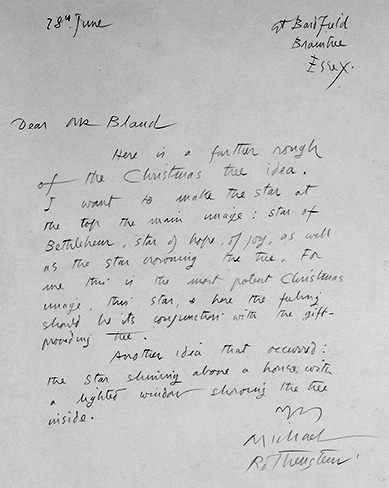
Below are two Christmas cards from Kenneth Rowntree his wife Diana and family.

Kenneth Rowntree – Christmas Card
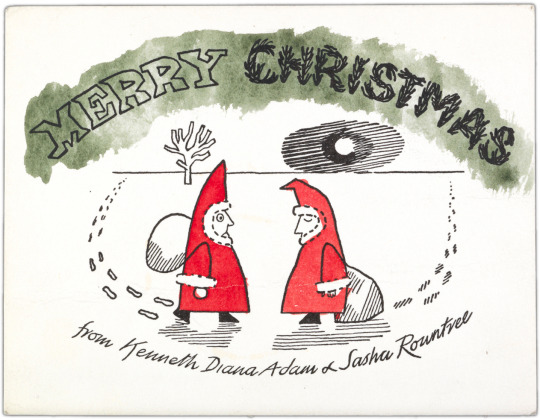
Kenneth Rowntree – Christmas Card
Below are some more images from other Great Bardfield artists.
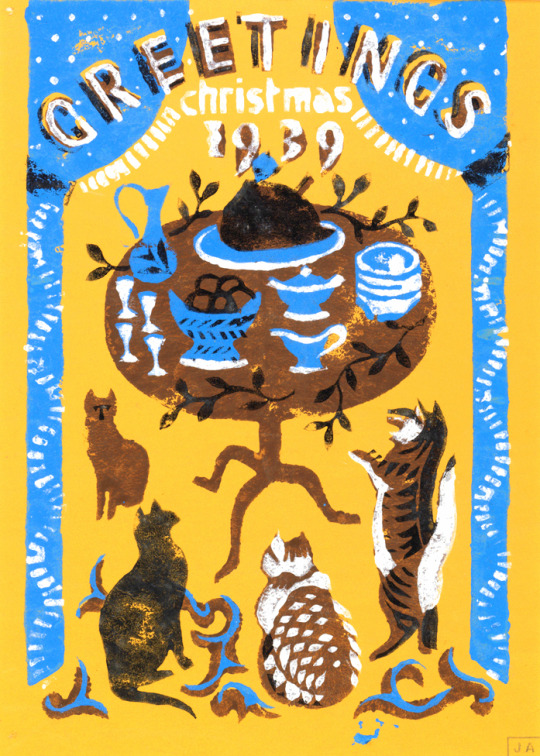
John Aldridge – Christmas Card
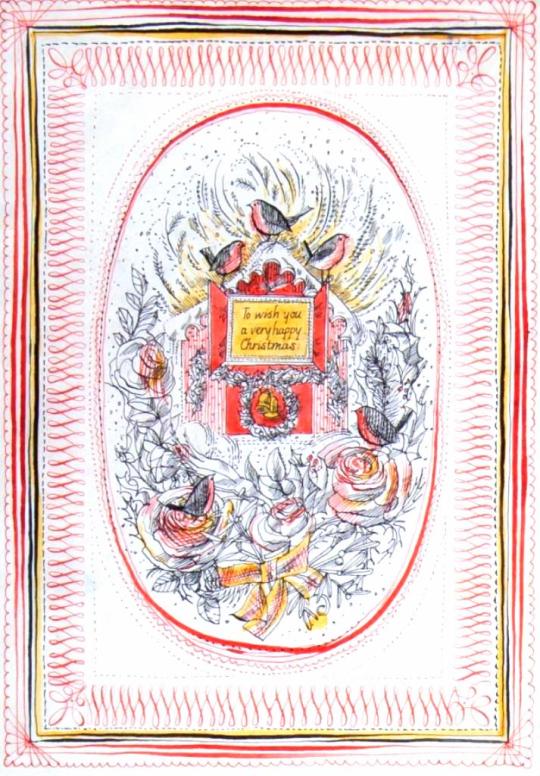
Sheila Robinson – Christmas Card Design
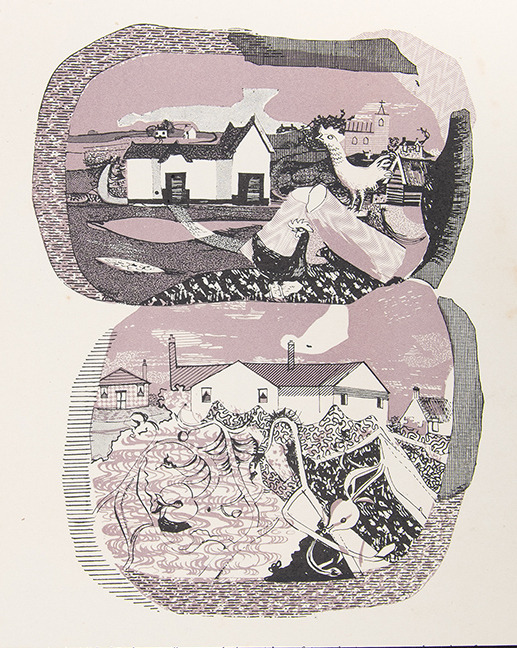
Michael Rothenstein – Christmas Card
I found a picture online by Kenneth Rowntree called ‘A Welsh Chapel’, painted in 1948. It was the same year Rowntree illustrated the King Penguin book ‘A Prospect of Wales’ so it maybe a study for that book, or it could have been work from the Recording Britain project. Either way, I thought it was sad to leave the picture without a location in the details, so I set about finding it.
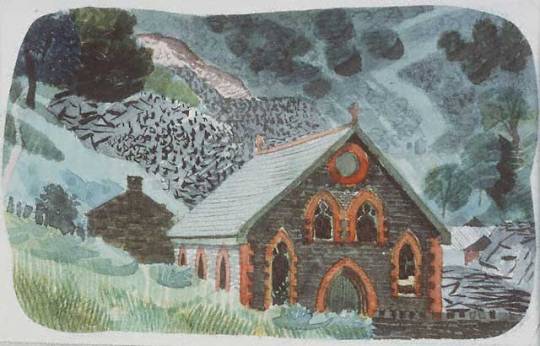
Kenneth Rowntree – A Welsh Chapel, 1948.
I searched on google images. After looking over pages and pages of ‘Welsh Chapel’ pictures on google I found a picture from a news report on the Daily Mail. (this has happened before with my picture of Downton) (I will add I hate the Daily Mail). The story was: Homeowners offer £1,000 reward for anyone who helps them to sell their £199,000 chapel through Twitter and Facebook. ‡
As you can see, the brickwork and windows match the paintings.
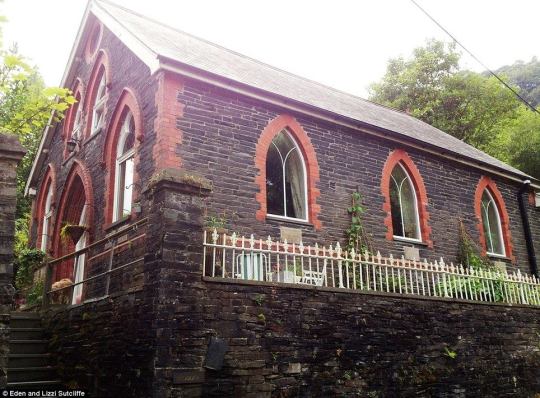

So next I wanted to make sure of the surroundings and I found a Street View picture on Google Maps of the Chapel, with the hills and houses behind it. I had it confirmed by proxy, by Peter Wakelin. The location is Corris, Merionethshire, off the A487.
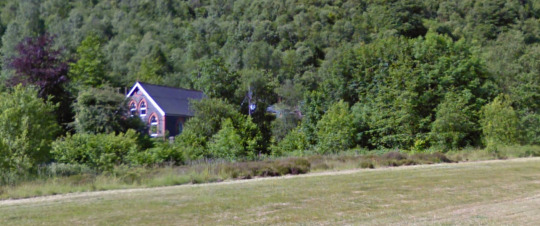
After looking in my copy of ‘A Prospect of Wales’ I found the picture below is featured as the 9th plate. It’s a picture of the School in Corris.
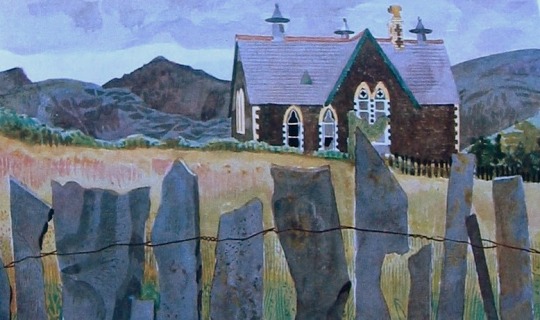
Kenneth Rowntree – School at Upper Corris, with Cader Idris, 1948.
Rowntree’s Wales is a hard-edged world of slate and stone, of country chapels, miners’ cottages, abandoned lead works, hill farms, remote schools and dry-stone walls. His eye for the ordinary and overlooked is as sharp as it is for the less familiar. Lettering, incised on tombstones or colourfully inscribed on shop fronts, is lovingly recreated; traffic signs, telegraph poles and other man-made structures become equally arresting elements in the composition. †
† http://www.independent.co.uk/news/obituaries/obituary-kenneth-rowntree-1271123.html
‡ http://www.dailymail.co.uk/news/article-2551620/Pray-quick-sale-Homeowners-offer-1-000-reward-helps-sell-199-000-chapel-Twitter-Facebook.html
The King Penguin book series were beautifully printed books. To me, they were like the Ladybird Books for adults, covering a wide range of unconnected topics and monographs.

A Prospect of Wales, illustrated by Kenneth Rowntree, 1948.
The motive for Penguin Books was to broaden its appeal to the public. While still a young company, Penguin shocked the Publishing world with paperback books for sale by known and respected authors. Before that the idea of paperback fiction was to expect an unknown author and a throw-away after use book.
The original run of penguin books were black and white inside and mostly text, with the iconic two stripe colour banding. The colour schemes included: orange and white for general fiction, green and white for crime fiction, cerise and white for travel and adventure, dark blue and white for biographies, yellow and white for miscellaneous, red and white for drama; and the rarer purple and white for essays and belles lettres and grey and white for world affairs.
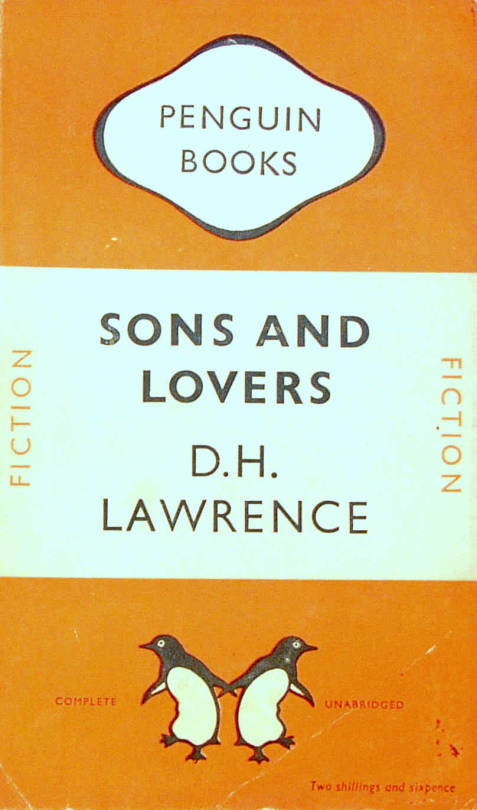
D.H.Lawrence – Sons and Lovers, 1948. Original Penguin Book cover.
They were an British knock off of the Insel-Bücherei (Island Library) series published in Germany by Insel Verlag from 1912 onwards. The size of the German books with their repeated pattern book coverings was an inspiration. The head of Penguin books is quoted:
“Why, we felt, should there not be a similar series of books in this country? The experiment, started a few weeks after war broke out, turned out to be successful. One of the most distinctive features of this series is their decorative covers.” †
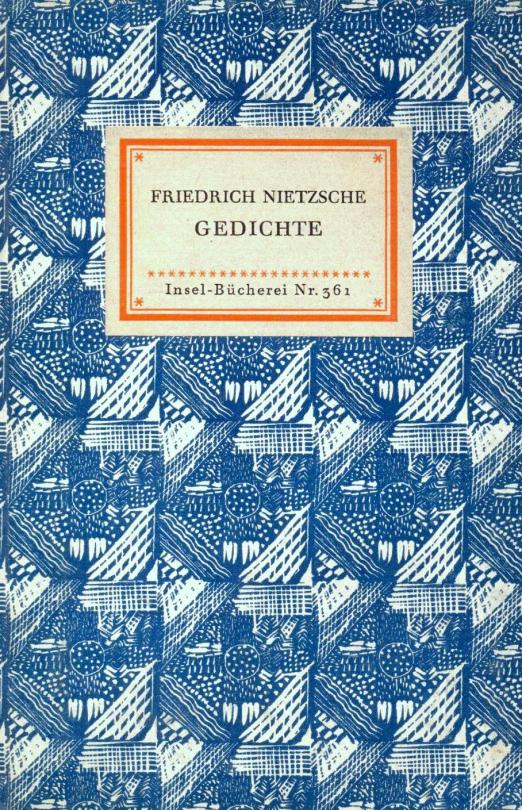
Friedrich Nietzsche – Poems. Insel Bucherei
“The aim of the King Penguin is different. These have not been planned to coincide with the public’s growing appreciation of art, but rather to appeal to the general liking for illustrated keepsakes of special projects.” †
The King Penguin series were also hardback books with colour lithographic illustrations, a move away from paperback and monochrome books.
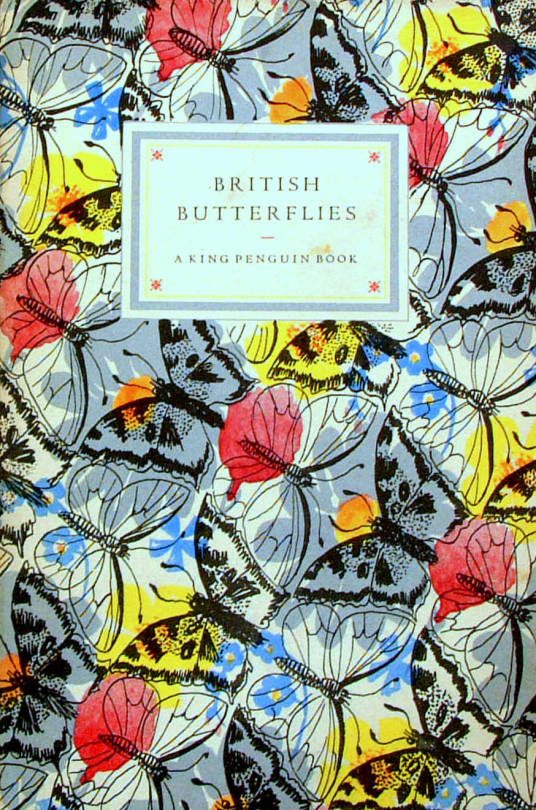
British Butterflies, cover by Paxton Chadwick, 1951.
The books originally combined a classic series of colour plates with an authoritative text. The first two volumes featured sixteen plates from John Gould’s ‘The Birds of Great Britain’ (1873) with historical introduction and commentary on each plate by Phyllis Barclay-Smith, and sixteen plates from Redouté’s Roses (1817–24) with historical introduction and commentary by John Ramsbottom. The third volume began the alternative practice of colour plates from a variety of sources. There were 76 volumes of King Penguin books in total.
Where as the educated scholars writing the books were the famous people at the time, today most people hunt for the illustrators, like John Piper, Edward Bawden, Hutton Clarke, Barbara Jones and Enid Marx.
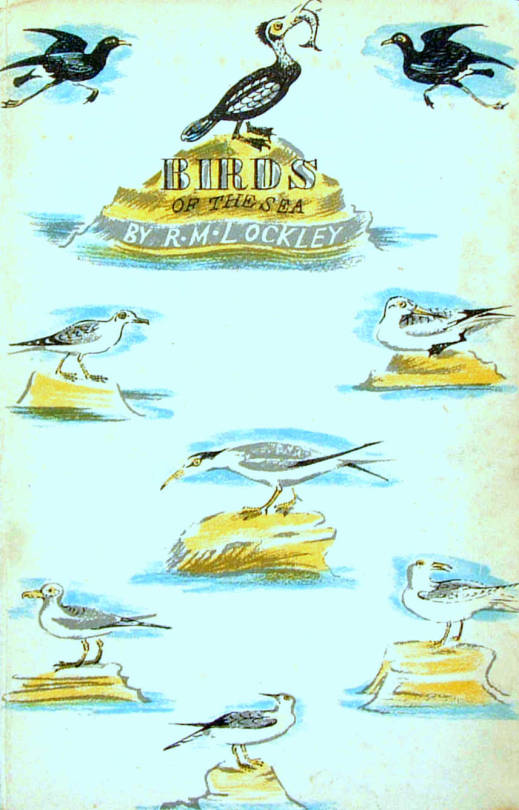
Birds of the Sea, cover designed by Enid Marx, 1945.
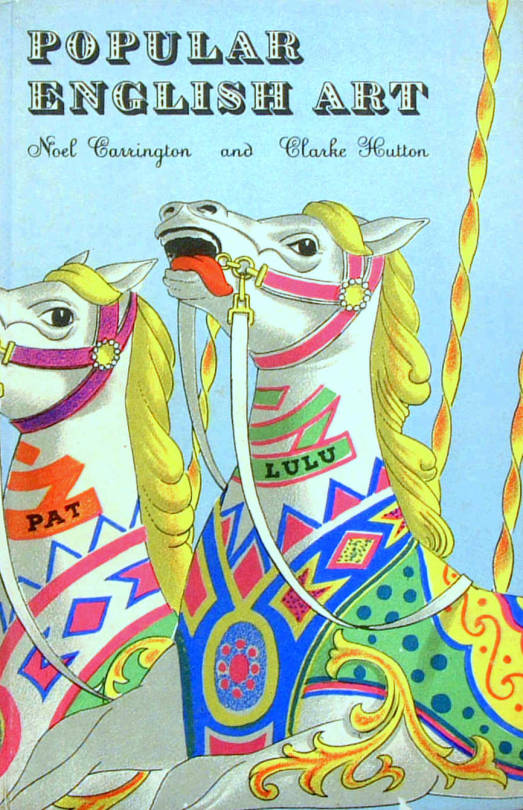
Popular English Art, illustrated by Clarke Hutton, 1945.
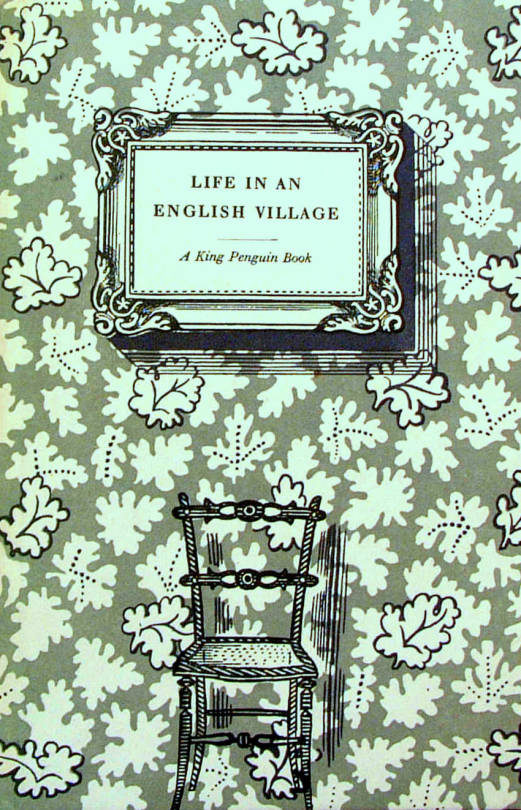
Life in an English Village, illustrated by Edward Bawden, 1949.
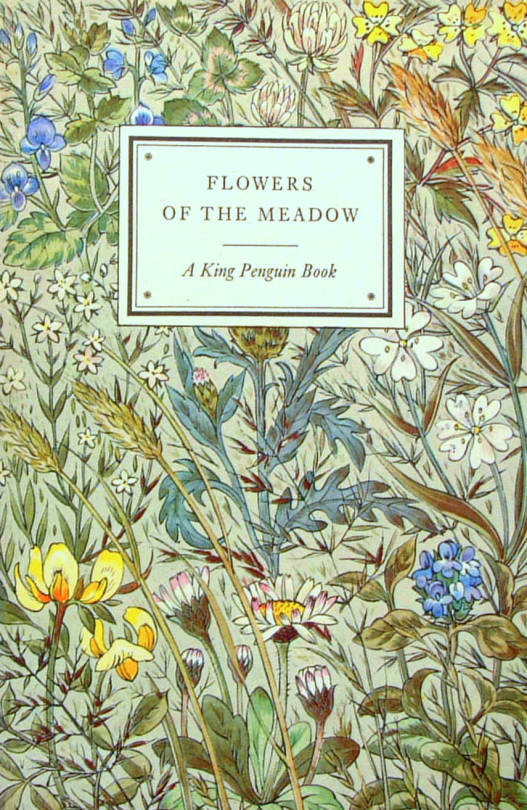
Flowers of the Meadow, Illustrated by Robin Tanner, 1950.
† The Private Library p143, 1977
During the Great depression in America artists were employed by the state to make works for the public. It was called the Federal Art Project and from 1935 the project was mostly famous for the murals in post offices, but it also covered sculpture and graphic design work. The project is said to have made 200,000 works from 1935 to 1943.
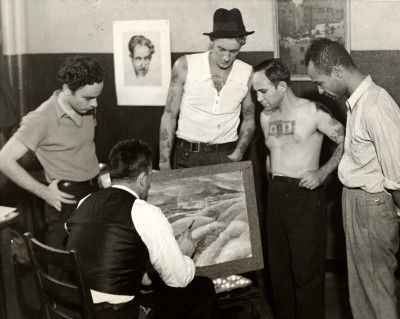
A charming picture of an Artist giving Art classes to Navy and Merchant Seamen at the Seamen’s Institute. 1935.
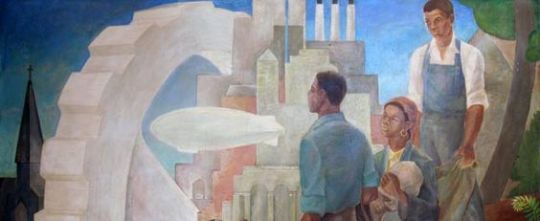
Vertis Hayes mural ‘Pursuit of Happiness’ painted in Harlem Hospital, NYC.
The director of the National Gallery, Sir Kenneth Clark was inspired by the Federal Art Project in the run-up to the Second World War years. In 1940 the Committee for the Employment of Artists in Wartime, part of the Ministry of Labour and National Service, launched a scheme to employ artists to record the home front in Britain, funded by a grant from the Pilgrim Trust. It ran until 1943 and some of the country’s finest watercolour painters, such as John Piper, Sir William Russell Flint, Rowland Hilder, and Barbara Jones were commissioned to make paintings and drawings of places which captured a sense of national identity.
Their subjects were typically English: market towns, villages, churches, country estates, rural landscapes; industries, rivers, monuments and ruins. Northern Ireland was not covered, only four Welsh counties were included and a separate scheme ran in Scotland.
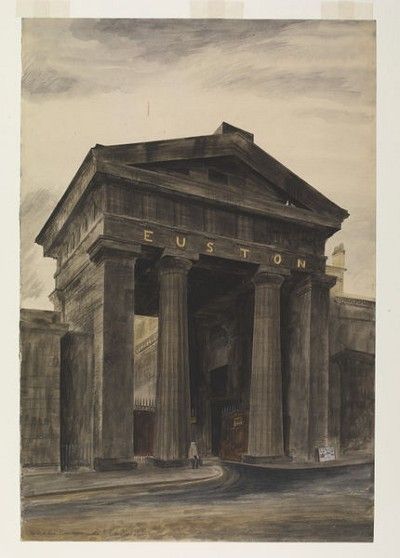
Barbara Jones: The Euston Arch for The Recording Britain project, 1943. V&A.
The premonition that Britain would be changed by WWII wasn’t the only motivation for starting the project, the ever expanding suburbs and new roads would mean that Britain was changing into a new industrial age.
The idea of a ‘vanishing Brtiain’ was also not new; in 1877 the Society for the Protection of Ancient Buildings (SPAB) was chiefly set up by William Morris and Philip Webb to conserve buildings in Britain. After the huge loss of life in the First World War, along with death duties, many family mansions where auctioned off and destroyed. (A practice that sadly went on long after the second world war.)
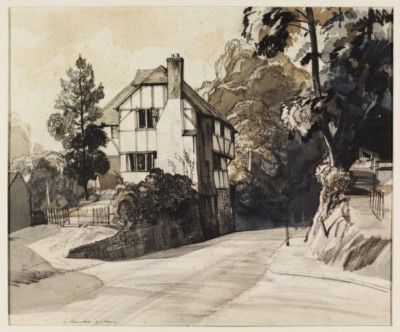
Rowland Hilder – The Old Cottage, Pulborough. 1940. V&A.
Another motivation for Clark was to help British artists during wartime and keep traditional art mediums fashionable. Many of the works were either done in watercolour or gouache.
In total over 1500 works were produced and 97 artists participated. The works were displayed three times during the war in the now, mostly empty, National Gallery and toured across Britain as a national moral boosting piece of propaganda.
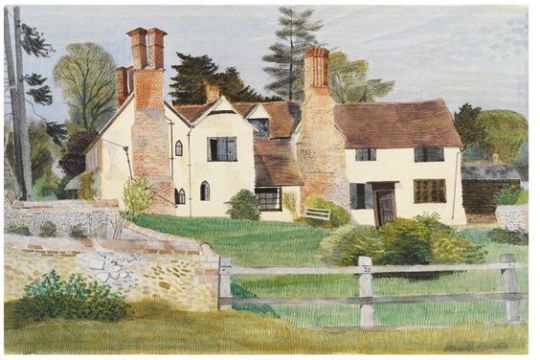
Kenneth Rowntree – Brent Hall from the South, Finchingfield. 1940. V&A.
The Pilgrim Trust donated the works to the Victoria and Albert museum, London in 1949. A four volume set of books was published and is now highly collectable. Two other books have been edited by Gill Saunders in 1990, 2011 and 2012.
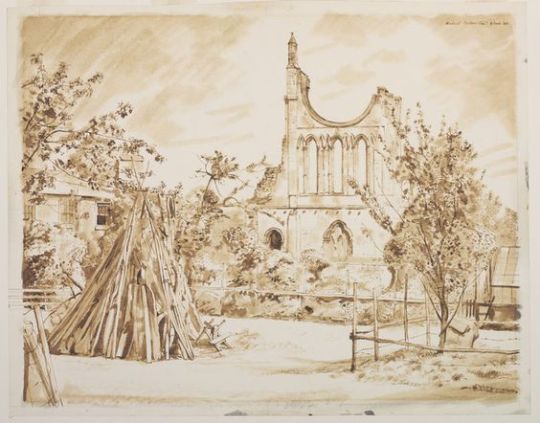
Michael Rothenstein – Byland Abbey – 4 June 1940. V&A.
These last works to Nikolaus Pevsner:
My answer to that is the War Artists’ Committee which was appointed at the beginning of the war to select artists as records of all kinds of war events. It has chosen its artists judiciously and on the whole put them into the right positions. It suggested to them subjects which were up their street anyway, and it left them an amazing amount of freedom as to how they wished to work. The result has been very good indeed. Henry Moore in the tube shelters, John Piper and Graham Sutherland amongst the bombed buildings, Stanley Spencer in machine shops, Eric Ravilious with the Fleet Air Arm, Edward Bawden in Abyssinia and so on — a record of which any country may be proud.
[And one more case-] Another group of young artists got their chance also by means of such a committee: the Recording Britain scheme of the Pi;grim Trust. Again, they were intelligently chosen to do a job of work which they liked to do: this time, the recording of anything they cared for in any county of Britain — Medieval castles, railway junctions, cottages, Victorian pubs, work in the fields, a deserted mine and iron stove and commandment boards in a church — anything. It has actually brought a few artists right into the limelight who had not before had quite such an opportunity to show what they could do: Kenneth Rowntree, for instance, and Barbara Jones. †
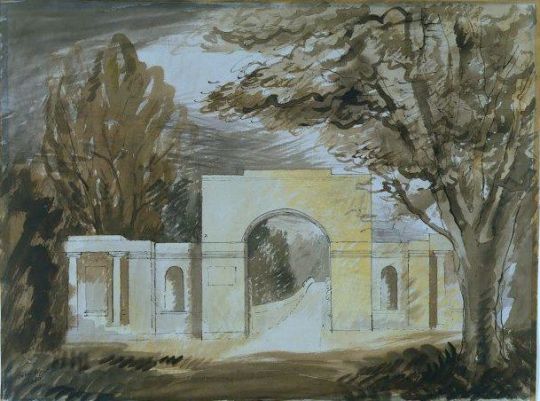
John Piper – Entrance Screen, Tyringham, 1940.
† From a radio broadcast ‘Art and the state’ from the show Art for Everyone. BBC Overseas Services — The Complete Broadcast Talks: Architecture and Art on Radio and Television.